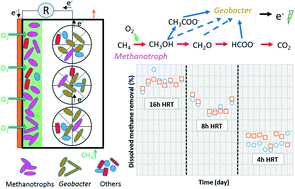当前位置:
X-MOL 学术
›
Environ. Sci.: Water Res. Technol.
›
论文详情
Our official English website, www.x-mol.net, welcomes your feedback! (Note: you will need to create a separate account there.)
Methane-driven microbial fuel cells recover energy and mitigate dissolved methane emissions from anaerobic effluents
Environmental Science: Water Research & Technology ( IF 5 ) Pub Date : 2017-10-10 00:00:00 , DOI: 10.1039/c7ew00293a Siming Chen 1, 2, 3, 4, 5 , Adam L. Smith 1, 2, 3, 4, 5
Environmental Science: Water Research & Technology ( IF 5 ) Pub Date : 2017-10-10 00:00:00 , DOI: 10.1039/c7ew00293a Siming Chen 1, 2, 3, 4, 5 , Adam L. Smith 1, 2, 3, 4, 5
Affiliation

|
The effluents of mainstream anaerobic treatment processes such as anaerobic membrane bioreactors (AnMBRs) contain dissolved methane that represents a large fraction of the available energy (approximately 50% at 15 °C) and a significant greenhouse gas (GHG) emission if released to the atmosphere. Microbial fuel cells (MFCs), which rely on exoelectrogenic microorganisms to generate electricity from organic or inorganic matter, could be used to recover energy and prevent GHG emissions from dissolved methane. Two replicate air-cathode, single-chamber MFCs and one dual-chamber MFC were constructed and operated in continuous mode on a synthetic, methane-saturated medium at 20 °C and hydraulic retention times of 4, 8, and 16 h. Up to 85% dissolved methane removal was achieved, resulting in the generation of 0.55 ± 0.06 V. Geobacter, a common exoelectrogen, and methanotrophs were identified in anode biofilm samples by Illumina sequencing targeting the 16S ribosomal RNA (rRNA) and 16 rRNA gene. Activity quantification of key microbial populations via reverse transcription-quantitative polymerase chain reaction (RT-qPCR) indicated that methane removal and voltage production results from a consortium of aerobic methanotrophs enriched in a cathode biofilm that produce intermediate metabolites (e.g., formate and acetate) that serve as substrates for Geobacter in the anode biofilm.
中文翻译:

甲烷驱动的微生物燃料电池可回收能量并减轻厌氧废水中溶解的甲烷排放量
主流厌氧处理工艺(例如厌氧膜生物反应器(AnMBR))的废水中含有溶解的甲烷,占可利用能量的很大一部分(在15°C时约为50%),如果释放到大气中,则会产生大量温室气体(GHG)排放。依靠外生电微生物从有机或无机物质中产生电能的微生物燃料电池(MFCs)可用于回收能量并防止溶解的甲烷产生温室气体排放。在合成的,甲烷饱和的介质上,在20°C和4、8和16 h的水力停留时间下,构造并连续运行了两个重复的空气阴极,单腔MFC和一个双腔MFC,并以连续模式运行。达到了高达85%的溶解甲烷去除率,产生了0.55±0.06 V.地杆菌,公共exoelectrogen,和甲烷氧化通过Illumina测序靶向16S核糖体RNA(rRNA基因)和16 rRNA基因阳极生物膜样品中鉴定。通过逆转录定量聚合酶链反应(RT-qPCR)对关键微生物种群进行活性定量分析表明,甲烷的去除和电压产生是由富集于阴极生物膜中的好氧甲烷氧化菌群产生的,该阴极生物膜产生中间代谢物(例如甲酸盐和乙酸盐),在阳极生物膜中用作Geobacter的底物。
更新日期:2017-10-31
中文翻译:

甲烷驱动的微生物燃料电池可回收能量并减轻厌氧废水中溶解的甲烷排放量
主流厌氧处理工艺(例如厌氧膜生物反应器(AnMBR))的废水中含有溶解的甲烷,占可利用能量的很大一部分(在15°C时约为50%),如果释放到大气中,则会产生大量温室气体(GHG)排放。依靠外生电微生物从有机或无机物质中产生电能的微生物燃料电池(MFCs)可用于回收能量并防止溶解的甲烷产生温室气体排放。在合成的,甲烷饱和的介质上,在20°C和4、8和16 h的水力停留时间下,构造并连续运行了两个重复的空气阴极,单腔MFC和一个双腔MFC,并以连续模式运行。达到了高达85%的溶解甲烷去除率,产生了0.55±0.06 V.地杆菌,公共exoelectrogen,和甲烷氧化通过Illumina测序靶向16S核糖体RNA(rRNA基因)和16 rRNA基因阳极生物膜样品中鉴定。通过逆转录定量聚合酶链反应(RT-qPCR)对关键微生物种群进行活性定量分析表明,甲烷的去除和电压产生是由富集于阴极生物膜中的好氧甲烷氧化菌群产生的,该阴极生物膜产生中间代谢物(例如甲酸盐和乙酸盐),在阳极生物膜中用作Geobacter的底物。



























 京公网安备 11010802027423号
京公网安备 11010802027423号